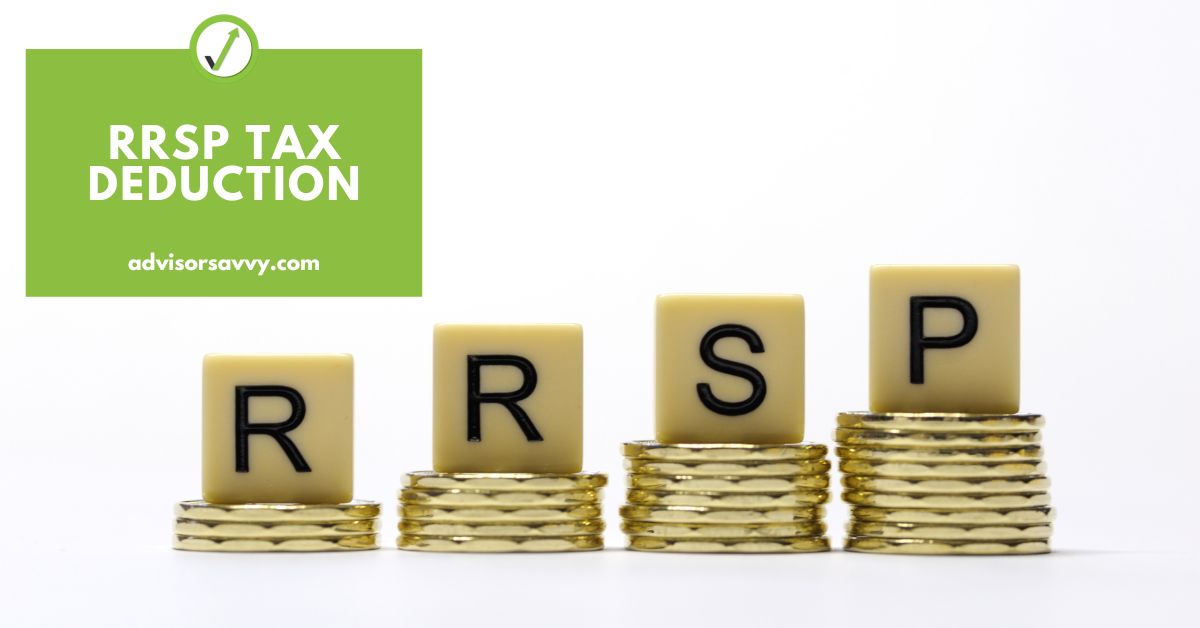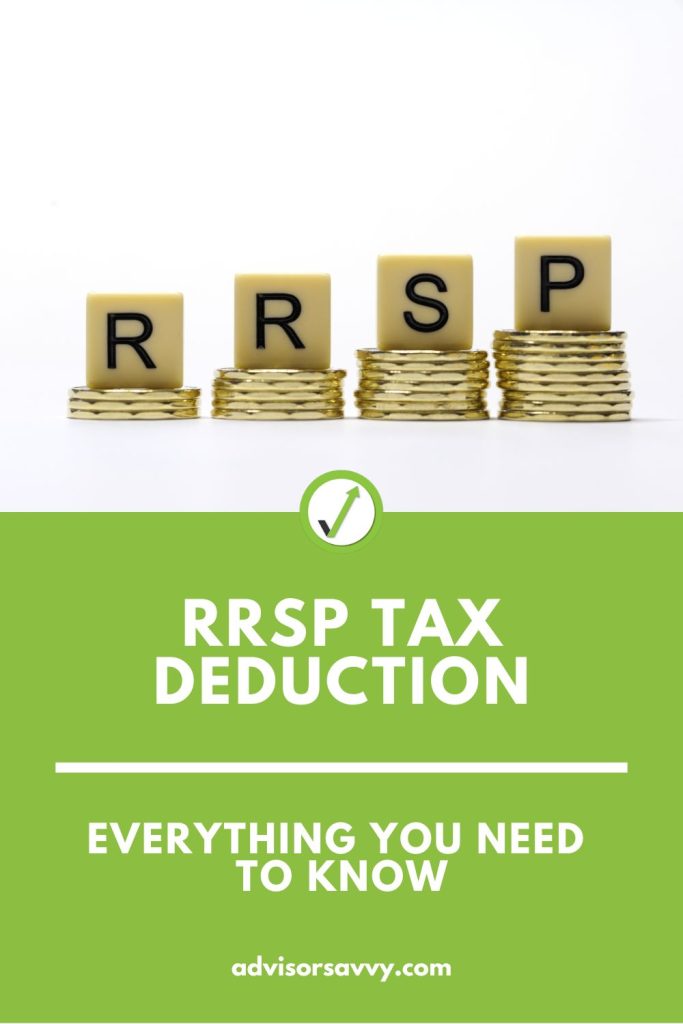
If you’re like most Canadians, you probably think of your Registered Retirement Savings Plan (RRSP) as simply a retirement savings account. While it is true that your RRSP can hold cash and other investments for your nest egg, it’s also a powerful tax tool. In fact, the Canada Revenue Agency (CRA) calls the RRSP the “single most important vehicle” for retirement savings. The main tax benefit of a RRSP is investment income is sheltered from tax. But another notable benefit is the RRSP tax deduction.

Table of contents
So what is the RRSP tax deduction? And how exactly does it work? Let’s take a closer look below.
What is the RRSP tax deduction?
Most people are familiar with the RRSP, or Registered Retirement Savings Plan. This is a retirement savings account that you can open with a financial institution, and it offers a number of benefits, including tax advantages. An RRSP is a registered account which means it’s subject to special rules surrounding contributions and withdrawals, as set by the CRA and Canadian government.
One of the main benefits of an RRSP is the tax deduction. When you contribute to your RRSP, you can deduct the amount from your income for tax purposes. This can help lower your overall tax bill. The deduction is available for both employed and self-employed individuals.
The amount of the RRSP tax deduction is limited to how much you can contribute to your RRSP in a calendar year. If you over-contribute to your RRSP, you will face a 1% tax on the excess amount for each month it remains in the account. Even though the RRSP tax deduction is lucrative, be sure not to break any contribution limits!
Related Reading: The RRSP In Canada: A Complete Strategy Guide
How do RRSP tax deductions work?
You can contribute to your RRSP at any time, but you have until March 1 to make contributions and still get a deduction for that tax year. Normally, all taxation relates to January 1 to December 31 financial activity – then a new tax year starts. However, the CRA gives individuals until March 1 to make a RRSP contribution as an opportunity for Canadians to tax plan. If you want to lower your taxes at the last minute, you can with a RRSP contribution!
The amount you can deduct is usually 18% of your previous year’s earned income, up to a maximum limit. For example, if you earned $50,000 last year, you could contribute up to $9,000 this year and get a deduction on your taxes. However, if you have extra room in your RRSP from previous years, you could contribute and access a higher RRSP tax deduction.
In Canada, the first step of the taxation process is to figure out your taxable income. If you made an RRSP contribution in the current tax year, you can reduce your taxable income by that amount. This means the base for the calculation of your tax payable will be lower, which means your tax obligation will be lower too.
How much do you get back in taxes for RRSP contribution?
The amount you “get back in taxes” depends on many factors. Your tax bracket, how much you contributed and other aspects of your taxes all play a role. In addition, your province or territory of residence affects your marginal tax rate. However, being able to reduce your taxable income is absolutely a benefit that shouldn’t be overlooked on your taxes.
In general, the higher your marginal tax rate, the more you’ll benefit from an RRSP tax deduction. However, it’s important to note that the deduction is only available if you contribute to a Registered Retirement Savings Plan, not other retirement savings contributions. If you want to maximize the benefits of your RRSP contribution, it’s best to speak to a financial planner or advisor.
Related Reading: How To Fix RRSP Over-Contributions
RRSP tax deduction calculator
An RRSP tax deduction calculator can be a helpful tool for anyone who is saving for retirement. By inputting your income and other information, the calculator can estimate the amount of money you will be able to deduct from your taxes. This can be a valuable planning tool, as it can help you to determine how much you need to contribute to your RRSP in order to maximize your tax deductions. Here are two resources you can use:
TurboTax RRSP Tax Deduction Calculator
EY RRSP Tax Deduction Calculator
This kind of calculator can also help you compare the potential tax benefits of different investment options. However, it is important to remember that the calculator is only a tool, and that your individual circumstances may differ from the assumptions made by the calculator.
Related Reading: Retirement Savings Calculator
What is the RRSP limit for 2023?
The limit for the 2023 tax year is $30,780. You can contribute up to this amount up until March 1, 2024 and claim it on your 2023 taxes.
Are RRSP contributions tax deductible?
Yes, contributions to a Registered Retirement Savings Plan are tax deductible. This means that you can deduct the amount you contribute to your RRSP from your taxable income. The deduction is limited to 18% of your previous year’s earned income, up to a maximum amount set by the government each year. However, any unused contribution room can be carried forward and used in future years. Sometimes people get confused between a TFSA and an RRSP. A TFSA does not offer a tax deduction, whereas an RRSP does.
How much will RRSP reduce my taxes?
For most people, contributing to an RRSP will result in a reduction in overall taxes. The amount of the tax reduction will depend on a number of factors, including your tax bracket, your province or territory of residence, and how much you have contributed to your RRSP. Also, aspects of your tax situation can impact the end result as well.
In general, the higher your income, the greater the tax deduction will be. Similarly, if you live in a province or territory with a higher tax rate, you will also see a greater reduction. Finally, the more money you contribute to your RRSP, the more you will reduce your taxes. While there is no guarantee that you will always get a tax reduction by contributing to an RRSP, for most people, it is an effective way to lower their taxes.
Are employer contributions to a group RRSP tax deductible?
Group RRSPs are a type of retirement savings plan that is sponsored by an employer. Contributions made by the employer are typically tax deductible, and employees may also be able to make pre-tax contributions to their plan. The money in a group RRSP can then be used to purchase annuities or other types of investments.
Employer contributions to a group RRSP are generally deductible for both the employer and the employee. However, there are some exceptions. For instance, if the employer makes contributions on behalf of the employee, they may not be deductible. Additionally, if the employee elects to have their contributions deducted from their pay cheque, they may not be able to claim a deduction for them.
Ultimately, whether or not employer contributions to a group RRSP are tax deductible depends on a number of factors. Consult with your accountant or financial advisor to determine if your situation qualifies.
Is RRSP loan interest tax deductible?
An RRSP loan allows you to capitalize on contributing to your RRSP when you don’t have the funds available. Not only do you optimize your RRSP, but you can access the RRSP tax deduction. Unfortunately, interest on a RRSP loan is not tax deductible. Because investment income earned in a RRSP is not taxed, the expenses incurred to earn that income are not tax deductible either.
Related Reading: Are financial advisor fees tax deductible in Canada?
Can I claim RRSP on my taxes?
The RRSP tax deduction is a great way to save money on your taxes while also working towards your retirement goals. Have you contributed to an RRSP this year? If not, consider doing so before the deadline on March 1, 2024. This way you can claim the RRSP contribution on your taxes. Just make sure not to go over your contribution limit!
Learn more: RRSP Contribution Deadline: How To Plan Ahead

